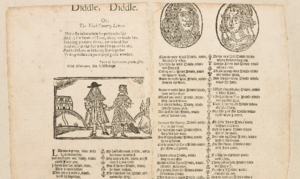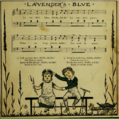Lavender's Blue facts for kids
Quick facts for kids Lavender's Blue |
|
|---|---|
| English folk song | |

A 17th-century broadside version of the ballad
|
|
| Catalogue | Roud 3483 |
| Genre | Nursery rhyme |
| Published | English broadside (before 1680) |
| Comment | collected in the UK & US |
"Lavender's Blue" (sometimes called "Lavender Blue") is a very old English folk song and nursery rhyme. It has been around since the 1600s! People have recorded many different versions of this song since the 1900s. Some of these recordings even became popular hits in the United States and the United Kingdom.
Contents
What are the Lyrics of Lavender's Blue?
This song has many different verses, and the words can change a lot from one version to another. There might be as many as thirty different verses! Here is a common version of the song, written down by James Halliwell in 1849:
- Lavender's blue, dilly dilly, lavender's green,
- When I am king, dilly dilly, you shall be queen:
- Who told you so, dilly dilly, who told you so?
- 'Twas mine own heart, dilly dilly, that told me so.
- Call up your men, dilly dilly, set them to work,
- Some with a rake, dilly dilly, some with a fork;
- Some to make hay, dilly dilly, some to thresh corn,
- Whilst you and I, dilly dilly, keep ourselves warm.
- If you should die, dilly dilly, as it may hap,
- You shall be buried, dilly dilly, under the tap;
- Who told you so, dilly dilly, pray tell me why?
- That you might drink, dilly dilly, when you are dry.
How Lavender's Blue Became Popular in the 20th Century
The song became very popular in the 1900s.
Burl Ives and Disney Film Success
In 1949, the famous singer Burl Ives had a hit song called "Lavender Blue." This version was featured in the Walt Disney movie So Dear to My Heart. It was even nominated for an Academy Award for Best Original Song! This means it was one of the best original songs from a movie that year.
Other Chart-Topping Versions
After Burl Ives' success, many people became interested in the song again. Several artists released their own versions, and some became very popular:
- Sammy Kaye's version in 1949 reached number 5 on the music charts.
- Dinah Shore's album Lavender Blue went all the way to number 1 in Australia in 1949.
- Sammy Turner's version in 1959 reached number 3 on the Billboard Hot 100 chart in the US.
Modern Interpretations and Folk Revival
In 1976, a group called The City Waites recorded the original 17th-century version of the song. They played it using old musical instruments from that time period. Later, in 1985, the British band Marillion released a song called "Lavender" on their album Misplaced Childhood. This song used some of the lyrics from the old folk song and became a number 5 hit on the UK music charts.
Images for kids


